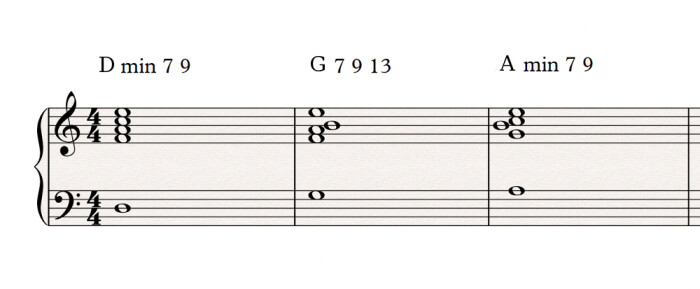The present article closes the mini-series we started with article 39 focusing on the use of voicings within the most common cadences. And we'll finish studying voicings based on added-tone chords looking at the interrupted cadence and rhythm changes. Let's go!

The interrupted cadence with added-tones
The interrupted cadence with added tones I suggest is the following:

To differentiate it even more from the “basic” interrupted cadence presented in article 40, I based it on a II-V-I progression, instead of IV-V-I. All chords are seventh chords with at least an added ninth, and even a 13th for the dominant chord (G).
For the dominant chord, we got rid of the fifth, as in many of our previous examples, to give way to the 13th (E). This allows you to have a constant pedal on the upper voice across the three chords. The bass voice simply follows the progression of the roots.
As for the middle voices, let’s start with the two first chords. The two first middle voices don’t change between the two chords. The third note, however, follow a downward conjunct motion from C to B. But between the second and third chords, right in the middle of the interrupted cadence itself, all three middle voices move upwards in a parallel conjunct motion. This unified movement of the three middle voices highlights more the modulatory character of the interrupted cadence!
Rhythm changes with added tones

Once again all chords are seventh chords and most of them have an added ninth, except for the A minor chord where the ninth, B, would’ve been hardly usable as part of the rhythm changes. Like with the interrupted cadence above, the fifth was suppressed from the dominant chord (G, again) to leave some room for the thirteenth, E, which also allows you to maintain a pedal across all voicings, in this case as the first middle voice.
The upper voice moves down following a progressive conjunct motion with a “pause” between the second and third chords. The lower voice is again made up of root notes of the corresponding chords.
The middle voices, apart from the E pedal we already mentioned, are pretty stable, as usual. The second voice plays two Gs followed by two Fs, while the third one follows a downward conjunct motion between the two first chords (from B to A) and then remains on the same note for the last three chords.
Generally speaking, rhythm changes are an interesting example of what you can achieve with a well-adapted voice-leading. In fact, its iconic bass line and its four-chord structure can already constitute a melody (in embryonic state) in the top voice.
As I announced at the beginning of this article, our brief review of the use of voicings within the framework of cadences has come to an end. In the next article we will deal with a somewhat different formula. Good music-making to everyone!


